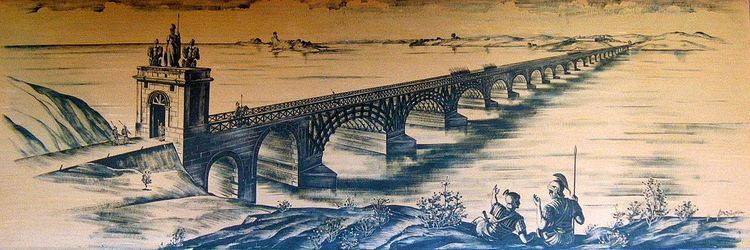Width 15 m (49 ft) Construction started 103 AD | Material Wood and Stone Height 19 m (62 ft) Total length 1,135 m | |
 | ||
Locale Heritage status Monuments of Culture of Exceptional Importance, and Archaeological Sites of Exceptional Importance, Serbia Hours Open today · Open 24 hoursTuesdayOpen 24 hoursWednesdayOpen 24 hoursThursdayOpen 24 hoursFridayOpen 24 hoursSaturdayOpen 24 hoursSundayOpen 24 hoursMondayOpen 24 hoursSuggest an edit Similar Iron Gates, Tabula Traiana, Iron Gate I Hydroelectric Power St, Iron Gates Region Museum, Rock sculpture of Decebalus | ||
Trajan s bridge
Trajan's Bridge (Serbian: Трајанов мост, Trajanov Most; Romanian: Podul lui Traian ) or Bridge of Apollodorus over the Danube was a Roman segmental arch bridge, the first bridge to be built over the lower Danube. Though it was only functional for a few decades, for more than 1,000 years it was the longest arch bridge in both total and span length.
Contents
- Trajan s bridge
- Trajan s bridge professional staff in position
- Description
- Tabula Traiana
- Destructionerosion and remains
- References
The bridge was constructed in 105 AD by instruction of Emperor Trajan by Greek architect Apollodorus of Damascus for the deployment of Roman troops during the conquest of Dacia.
Trajan s bridge professional staff in position
Description
The bridge was situated East of the Iron Gates, near the present-day cities of Drobeta-Turnu Severin in Romania and Kladovo in Serbia. Its construction was ordered by the Emperor Trajan as a supply route for the Roman legions fighting in Dacia.
The structure was 1,135 m (3,724 ft) long (the Danube is now 800 m (2,600 ft) wide in that area), 15 m (49 ft) wide, and 19 m (62 ft) high, measured from the surface of the river. At each end was a Roman castrum, each built around an entrance, so that crossing the bridge was possible only by walking through the camps.
The bridge's engineer, Apollodorus of Damascus, used wooden arches, each spanning 38 m (125 ft), set on twenty masonry pillars made of bricks, mortar, and pozzolana cement. It was built unusually quickly (between 103 and 105), employing the construction of a wooden caisson for each pier.
Tabula Traiana
A Roman memorial plaque ("Tabula Traiana"), 4 metres wide and 1.75 metres high, commemorating the completion of Trajan's military road is located on the Serbian side facing Romania near Ogradina. In 1972, when the Iron Gate I Hydroelectric Power Station was built (causing the water level to go aprox. 35 m higher), the plaque was moved from its original location, and lifted to the present place. It reads:
IMP. CAESAR. DIVI. NERVAE. FNERVA TRAIANVS. AVG. GERM
PONTIF MAXIMUS TRIB POT IIII
PATER PATRIAE COS III
MONTIBVS EXCISI(s) ANCO(ni)BVS
SVBLAT(i)S VIA(m) F(ecit)
The text was interpreted by Otto Benndorf to mean:
Emperor Caesar son of the divine Nerva, Nerva Trajan, the Augustus, Germanicus, Pontifex Maximus, invested for the fourth time as Tribune, Father of the Fatherland, Consul for the third time, excavating mountain rocks and using wood beams has made this road.The Tabula Traiana was declared a Monument of Culture of Exceptional Importance in 1979, and is protected by the Republic of Serbia.
Destruction/erosion and remains
The wooden superstructure of the bridge was dismantled by Trajan's successor, Hadrian, in order to protect the empire from barbarian invasions from the North.
The twenty pillars were still visible in 1856, when the level of the Danube hit a record low.
In 1906, the Commission of the Danube decided to destroy two of the pillars that were obstructing navigation.
In 1932, there were 16 pillars remaining underwater, but in 1982 only 12 were mapped by archaeologists; the other four had probably been swept away by water. Only the entrance pillars are now visible on either bank of the Danube.
In 1979, Trajan's Bridge was added to the Monument of Culture of Exceptional Importance, and in 1983 on Archaeological Sites of Exceptional Importance list, and by that it is protected by the Republic of Serbia.
